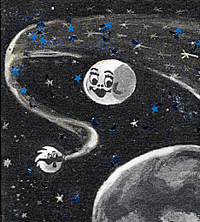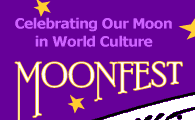
|

|
THEATER
Programming suggestions for a MOONFEST Theaterfest:
Produce a staged reading of "Moon Scenes from Shakespeare":
- Romeo and Juliet: "Swear not by the moon, the inconstant moon"
- Macbeth: "Upon the corner of the moon There hangs a vaporous drop profound; I'll catch it ere it comes to ground"
- A Midsummer Night's Dream: "Ill met by moonlight, proud Titania" . . . "Therefore the moon, the governess of floods, Pale in her anger washes all the air . . ." See also Pyramus & Thisbe, the play within the play, in which the character Moonshine plays a prominent part.
- See also Othello, The Merchant of Venice, The Taming of the Shrew, Julius Caesar and Love's Labours Lost.
Or use scenes from the works of other playwrights:
- Tom, Amanda and Laura Wingfield make wishes on "a little silver slipper of a moon" (Tennessee Williams's Glass Menagerie)
- Rebecca Gibbs expresses her fear that the Earth and the moon will collide (Thornton Wilder's Our Town)
- Matt Friedman's moon-drenched opening monologue in Lanford Wilson's Talley's Folly
- The uproarious scene between DeGuiche and Cyrano, who posits seven methods of moon travel as he claims to have fallen from the moon (Edmond Rostand's Cyrano de Bergerac)
Share this website on social media and via email!
|
|

Graphic by Candy Drew for her
children's musical, Luna Muna
|
Moon gods and goddesses appear in ancient Greek, Roman, Egyptian, Incan,
Babylonian and Inuit cultures.

In Judaism, the new moon signifies a new beginning. Special prayers are
said when the new moon falls on the Sabbath. In some branches of Judaism,
young girls’ and women’s groups are organized around the appearance of the new moon as a symbol of empowerment.

In Christianity, Easter coincides with the first full moon after the vernal
equinox. In early Christianity, the Virgin Mary was identified with the
moon. Paintings and icons from the Middle Ages depict Mary standing on
a crescent moon.

In Islam, the crescent moon is a vital symbol. Ramadan begins with the advent
of the new moon. It’s said that Mohammed was able to make the moon disappear up one sleeve and reappear from the other.

In the Hindu religion, the moon is believed to be a temporary resting place
for the soul between incarnations. The soul then returns to Earth through
falling rain and enters the body through a man’s semen.
Source: The Upanishads
|
|



